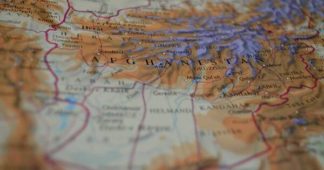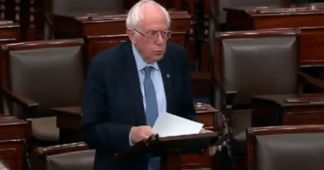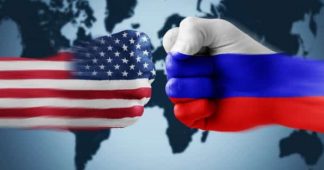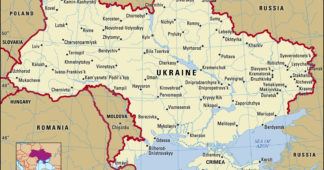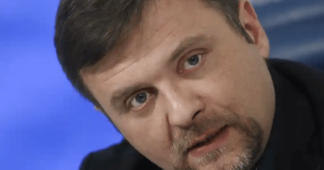Jair Bolsonaro, Brazil’s far right president, is launching a reelection bid and currently trailing in the polls behind former president and liberal rival Luiz Inácio Lula da Silva. Bolsonaro and conservative lawmakers have worked to slash environmental protections and promote development of the Amazon rainforest, where deforestation appears to be accelerating as Brazil prepares for elections in October. Deforestation is a major cause of climate change and a threat to Indigenous people who are organizing to resist land grabs and toxic pollution from illegal mines. To learn more, Truthout’s Mike Ludwig interviewed Romulo Batista, an environmental activist based in Manaus, a Brazilian city nestled in the Amazon rainforest.
Music by Dan Mason
TRANSCRIPT
This is a rush transcript and has been lightly edited for clarity.
Welcome back to Climate Front Lines. Today we are going to the Amazon rainforest in Brazil, one of the most diverse bioregions on the planet. The Amazon rainforest is also one the world’s most important carbon sinks and must be preserved to avoid the worst impacts of global warming. But new satellite data show that deforestation of Amazon is accelerating compared to last year, when 4.8 million acres were destroyed to make way for development, both legal and illegal.
The slash-and-burn logging, mining, cattle ranching, and other industries that cause deforestation in the Amazon are also major sources of pollution and land loss threatening Indigenous communities, who are currently preparing for an annual meeting in Brasilia, the nation’s capital. Land grabs and climate justice are at the top of the agenda for the summit, known as the Free Land Camp, and we should all be paying attention, because deforestation is also a threat to the rest of us as the climate crisis intensifies.
It’s campaign season in Brazil, and environmentalists say corporate politicians are working furiously to speed up development of the Amazon before the country holds elections in October. Our guide to the Amazon rainforest is Romulo Batista, an activist and spokesperson for Greenpeace. Batista comes to us from Manaus, the capital city of Amazonas, a large state in northwestern Brazil that is almost entirely covered by the Amazon rainforest.
Mike Ludwig: The first thing I wanted to ask you about is that in the press release that said that Greenpeace reports, that deforestation alerts are up 62 percent compared to the same month last year. What exactly is a deforestation alert and, I think it’s the DETER system, the D-E-T-E-R system?
Romulo Batista: Yes. Here in Brazil, we have two different systems that make the monitoring of deforestation. One of those is the PRODES that gives the official texts of deforestation. They are published once per year. DETER is a kind of lens of deforestation. It means that they can release it quickly, but it’s not seeing all of the Amazon, they see patches that are bigger than PRODES. It means that we do not see these very small patches of deforestation because of this, we have different areas when we [observe deforestation over the same time period] in DETER and PRODES.
Okay. So, the DETER system, essentially, how was it observed? Does it basically just come down to the amount of acres that have been deforested or had the trees cut down?
Yeah. It’s based on satellite imaging. It means that they pass by each four days, these satellite images are made for the same place. This is the beginning of the year, we are in the rainy season here in the Amazon. It means a lot of cloud cover, as we call, it means that [the satellites] do not see all the areas of the Amazon. When we think about this, this means that probably the [levels of deforestation] can be higher than what we have in the [DETER] alerts, because someplace during our February, our January, will be covered by clouds.
Gotcha. And can you tell us a little bit about the environmental regulatory structure in Brazil and how the Bolsonaro government has contributed to this increase in deforestation?
Yes. Since I our re-democratization in Brazil in 1988, we have built a very strong environmental laws and environmental organizations, until we start to lose when the Bolsonaro government started 2019. Just to give you an example, between 2004 and 2012, Brazil saw a decrease in almost 80 percent of deforestation in the Amazon. It’s a cut of 27,000 square kilometers [to] less than 5,000 square kilometers. Because what we, we did is first build more science, for example, the DETER program was launched at that time.
We have more people going inside of the [Amazon] and are proof of organized control of deforestation here. We had the launching of the Amazon Fund that received money from different governments and companies to apply this money, to control the deforestation. These make a lot of difference in the trajectory of the deforestation, but since the beginning of our president here in Brazil, he said for everyone that he will finish the industrialization of the environmental views here in Brazil. [Inaudible]
Are you saying that the Bolsonaro government has said that it wants to get rid of the environmental oversight or the people who are watching the Amazon?
Yeah. Yeah. It’s exactly what they say. They cut money, for example, last year, it was this smaller budget for the Ministry of the Environment from the last 20 years, when we make compilation and you’ve applied inflation on this. But it’s the smaller than in the last 20 years, the number of operations to control deforestation and fires in the Amazon was smaller than the last 20 years too.
When we saw all the tracts, the polygons of deforestation, less than 1 percent of these polygons was make a kind of the, they make the bills [inaudible] together with the Congress that are trying and push very hard to pass different projects of laws that we will open the forest for more destruction.
Just to giving you an example: Last week, we have the approval to vote in emergency the opening of Indigenous land for mining, for build of hydroelectric plants or to rent the soil for agriculture. It’s important to say that the states here in, in the Amazon, or in Brazil, have responsible responsibilities to do to do cultural [mitigation] of deforestation, but unfortunately, they have much less money than the federal government. And in some of these states, there is no interest from the government or the state government to make this kind of operations to stop deforestation.
So, you said that they want to build a hydroelectric project on Indigenous land?
Yeah, because nowadays we have laws, and we have international presuppose that Brazil is signatory, for the example international [agreement], it says, if you will do any kind of any kind of infrastructure that will affect Indigenous land, these guys have to be free and prior informed and have the power to stop the project.
What they want to do, now, is take out this power. The Indigenous people can be listened [to], but they do not have the rights to, for example, to deny the hydroelectric [plant] to be built inside their own land. Or a mining company goes inside to mining gold or aluminum or whatever. Eh, it’s [projects] like these that the president can give the authorization without the consultation of these people. It means that they will not have the rights to define what they want to do in their own lands. This is another law, another very bad example that we have, it’s already passed in the deputy house, it’s in the congress, in the Senate house for [consideration.] It’s a project of law that will give can give up 2,500 hectares of land for those that make a land grabbing in the Amazon, [it has passed chambers of the legislature and is the Senate for a vote]. It means that unfortunately it’s not only in the federal government, but in the congress house too, that we have people pushing for bad laws that [will increase] a lot the deforestation of the Amazon.
And so basically what you’re saying is, Bolsonaro’s government has done every, everything it can to dismantle environmental regulations. And now lawmakers are also pushing to dismantle protections. At the same time, taking the rights away from Indigenous people to have a veto power or to be consulted when destructive projects show up in the Amazon rainforest.
Yes, exactly. And the result is what we are seeing. Since 2019, the deforestation skyrockets, it’s almost double from what we saw 2018 from what we saw in 2021, these go up and up. If you only look at January and February this year, we have, we have, we have a number of 629 square kilometers. Last year it was 206. It means that this year we had three times more deforestation in two very first months in the Amazon. And this is very, very dangerous, because we are in the middle of the rainy season when we supposed to have a decrease in the deforestation, because it’s a lot of rain and that makes it difficult to access points of the forest.
So, if deforestation is happening at a much faster rate, even in the rainy season, when it’s tougher to go and cut down all the trees. What can you tell us about the Indigenous people who are threatened by the government and the land grabbing companies that are trying to exploit the natural resources there? Who are they? What are they called?
In the truth on the Amazon, we have more than 200 different groups of Indigenous people. We can say at least three right now have a huge problem with illegal mining. These wildcat mines for gold, the price of the gold skyrockets since two years [ago], it makes this new gold rush in the Amazon happening.
We go more to the north of the Amazon in the Roraima States, we have the Yanomami people that in their land, eh, it’s something close to 20,000 illegal mines, that are running on gold mining. We have in the Pará State, on the Tapajós river on three different lengths from the Munduruku indigenous people, we have something close to 20,000 illegal mines too.
We have the Caiapós with the same problem in Mato Grosso State. It is true, all along the Amazon there is invasion. When a company wants to go to mining, they have to submit a kind of a license, and say “I would like to be mining in these areas.” When we cover this ask for license with the boundaries of different Indigenous land, some of those are completely overlapping with this license, with this ask for license to mining. Several indigenous land lands, several people will be affected if this project of law is passed, and if the environmental license in Brazil changes as it is proposed by the congress too, by the way.
So, you’re facing twin threats of deregulation, where it’s easier for the big mining companies to come in and cut down the trees and then extract the metals from the ground. But you’re also facing a massive inundation — and especially on Indigenous lands — of illegal mines. Are these like big companies, are they just like rogue operators who go out there and just start digging holes? What does an illegal mine look like?
The illegal mines, when we overflight several times, all these areas.
You flew over them in a plane?
Yeah. Yeah. Yeah. When we talk about illegal mines people have in their mind, this poor guy alone on the river, trying to get some small portion of gold. But when we go through these places in the Indigenous land, you see a huge amount of destruction, they use heavy machines to do this. They pump the water into the soil. They use these [inaudible] it’s not a kind of small-scale gold mining. No. We are talking about 20,000, the government do nothing. They know what these guy, these guys are, because we have the best program of monitoring the deforestation of a tropical forest in the world.
It’s possible to know this DETER data either give to us what is the deforestation coming from illegal mining inside the indigenous lands. Then they know the place. And these guys, they use machines that this, that costs something close to $200,000. When you reach people that are financing these guys, we have politicians, we have business man, we’ll have doctors and different kinds of people that put money to try to make much more money. Once it’s illegal, they will not pay tax. They will not have to pay labor rights for these people. They do not have to pay to buy the land, buy the license, buy nothing. They just put their money and make these increases several times, once the operation is going on.
It’s important to say that it’s not only environmental destruction, that these illegal miners cause, they are poisoning the Indigenous people. On the Indigenous land in Para State…90 percent, nine zero, 90 precent of the Munduruku people have this mercury in the blood. So [these levels of mercury] are much higher than what, for example, the World Health Organization say that is acceptable [for] human beings. Because they use this mercury to separate the gold from the other things that they are mining. It means that not only this, but these poisonings … all this mercury that is poison goes into the river and on the river, they contaminate the plants and the fish, and fish is the base of the food of these guys.
This contamination comes here where I am in Manaus city, it’s a huge city with 2 million persons, but a lot of fish that we consume here comes from the countryside and comes from some rivers that are affected by illegal mining too.
And of course, mercury is a heavy, often liquid metal. And it’s one of the problems with it as a pollutant and as a poison for not only fish and plants, but for human beings is it doesn’t break down in water. It doesn’t break down in the soil. So, if one animal consumes it and another animal consumes that animal, like a fish eating a smaller fish, it will just keep going. It doesn’t go away once it enters the environment. So that is terrifying.
Yeah. It’s what we call bioaccumulation of the poison in this case.
Bioaccumulation.
Yeah, because of that, it’s all obvious. If you live close to a river, you always go for the biggest fish. Because if you have to get food for your family or for your group of families, it’s pretty common that Indigenous people live in big communities and they have people that go to fish, and they want to get the big one. And because of these, you have a lot of accumulation because they take time to grow bigger and bigger, and these make a very problematic issue…
So, people are eating the biggest fish. And then as the mercury remains in the environment, it bioaccumulates in the fish that people are eating and then when people get tested, you said, I just want to go over some of the numbers really fast. You said 90 percent in some of these areas, Indigenous people are testing for elevated levels of mercury in their blood?
Yeah. 90 percent including in the milk of the mothers passing by for the children, that is a big problem. You can have in some villages that are in place, that you have high incidents of these illegal mining, this number can go to 100 percent. And this is not research made by Greenpeace. It’s come from a few crews that is the most respectful health [authority] in Brazil that make this research. We researched together with them to see this accumulation in some species of fish, but with the results we wanted to have [data on people living in the areas as well].
Now, I’ve seen videos of Indigenous people protesting in the streets, like in the cities, over deforestation and the illegal mining. How are indigenous people resisting this destruction and how are their activists allies also resisting, or what kind of action needs to be taken to prevent this destruction?
Yeah, the Indigenous movement in Brazil, it’s, they are the guys that doing probably the most important work as organization nowadays in Brazil. I always think of [an Indigenous activist in Brazil]. When Bolsonaro was elected, I asked her, what are you going to do now with this president? And she said, “well, have been fighting for our rights and our lands in the last 500 years, what are you going to do now about this new president,” you know?
They have been fighting for land rights, for cultural rights, for everything, nothing that they [inaudible] in our constitution in 1988 and all the recognizing for the land territories and how the land that they are getting back … but the movement is very strong.
We have a partnership with them since 2010, we participate together with them in the Free Land Camp. Free Land Camp is the biggest meeting of Indigenous people that’s happening every year in April during one week. Last year, it’s 6,000 of indigenous leadership meeting in Brasilia to protest and to ask for the congress and for the government, for the supreme court to respect the rights and to advance in the demarcation of Indigenous land. More attention on health. We have big problem with COVID, eh, in Indigenous territory.
Did you say COVID?
COVID yeah. Yeah. They lose lots and lots of Indigenous people by COVID because they do not have access to health care, or they are far away from the cities and the government not take care of them, one thing that’s obligation by our constitution, the government has the obligation to give health, education, good conditions for these people, but this does not happen. And in the last three years, it’s become worse than worse. I just saw a declaration from … one of the oldest and most important, eh, indigenous leadership in Brazil and what they say in the beginning of the, if I’m not wrong, is that the FUNAI, the FUNAI is the national institute of Indigenous people that was supposed to be who takes care about Indigenous rights and try to promote health and education for these people, that they are abandoned by FUNAI, the exact word is FUNAI now don’t like Indigenous people. This is very serious coming from … very, very important Indigenous leadership here in Brazil.
So, under Bolsonaro, Indigenous power and even the institute that was supposed to look out for Indigenous people has just been gutted at a time when deforestation is increasing?
Yeah. At the same time, you have attack of the congress with these laws increasing the deforestation, and those that have the application to take care about Indigenous rights and land territories, land rights, it just does not work and [lawmakers] have decreased a lot of money that went to this foundation. And now these words come that they do not like Indigenous people, they are bothered by FUNAI.
Oh. And this is why the United Nations and experts around the world say one of the critical things that must happen if we are going to combat the climate crisis is to empower Indigenous people and to respect their sovereignty of land, because their land stewardship is going to be a lot different than an illegal mine or heavy cattle grazing, where the trees just get cut down and we lose that carbon sink. Can you tell us a little bit about the climate implications of all this? How does the Amazon rainforest protect all of us from climate change?
Well. There is at least several ways that the Amazon. The first thing, most obvious Amazon, it’s a tropical rainforest and they regulate how the climate and how much humidity we have here in South America. There is a mechanism called flying rivers that push all this humidity that we have in this region and go through the South America and make a kind of irrigation on the biggest states that produce, by the way, that produce soy, cattle, rice, corn, whatever they produce. It means it’s about food security, too. Secondly, the forest it’s a huge, it’s a huge carbon stock.
Like a carbon sink?
Yeah, it’s a carbon sink, they observed, but they have a lot of carbon or wrapped up in it [inaudible]. The Amazon takes a long time to grow, to grow old growth forest.
And once you cut and burn, you release tons and tons of greenhouse gases. Just in Brazil when you saw deforestation is the main cause of emissions of green gas houses, 46 percent of our emissions come from deforestation, because once they cut, they burn this forest to use this land and the vast majority of the area that is cut in the Amazon become a pastoral land to produce cows and beef.
Produce cows and beef, and that’s what’s known as slash and burn right? Where they cut down the trees and they burned them and then they turn them into cattle farms?
Yeah, slash and burn, it’s a more traditional use that we have here, a small patch to produce maybe some corn or potatoes, whatever. We are talking here of patches of deforestation from 2,000, 5,000, 6,000 hectares. Just to have an idea, it’s necessary to have $200 U.S. dollars to make one hectare of [cleared forest.] If you have money to do these in 2,000, 3,000, 5,000 hectares, it means that it’s someone that have a lot of money. It’s farmers, or either land grabbers that just cut the forest and make a way to get a kind of a piece of paper that they call a property paper and sell this area.
It’s important to note that the last year, more than 40 percent of the deforestation in the Amazon is happening in areas that it’s a government property but do not have any designation. That means that you have a land that’s part of the federal government or state government, and they do not create a protected area for Indigenous land, to give these small farmers land to produce, these people just come inside these areas and it’s stolen, that is despite our procedures because if it’s part of the federal government, it belongs to me and for everyone, but these guys are just stealing these lands and making a lot of deforestation.
So basically, land grabbers are coming in, they’re just taking public lands that are supposed to be owned by the government and the people of Brazil, and they’re cutting down the trees, they’re burning them, and they’re either flipping it and selling it to farmers. Or the farmers are just coming in and using the land.
Yeah. Yeah, exactly. They can sell for them, or, either the farmer can do this or the land grabber, deforestation, fire, and put some pasture to create cattle.
What should we be doing in the United States to support these Indigenous people and the movement to prevent deforestation in Brazil? Because obviously this is a threat to the Indigenous people who live there. But as you mentioned, they’ve been fighting this struggle for 500 years, this is just the latest phase of that struggle. How can we support them? And what would, what advice would you have for people in the United States who are concerned about this issue? Since, like I said, it affects Indigenous people directly, but with the climate, it affects all of us.
Yeah. There are different ways to support. First know about what’s happening in the Amazon. It’s so important for humanity. Without the Amazon, we will not achieve the goals for the Paris agreement, by the way, so know what is happening. Make pressure on your own candidates that that they’re not allowed, for example, to buy products of Brazil that come from deforestation or come from Indigenous rights violations. Make pressure on the company, “ah, you are buying Brazilian soy or Brazilian beef?” To be sure that they can guarantee that these not come from deforestation, that these not come from Indigenous a rights violation.
It’s possible demonstrate support on social media, this kind of cyber activism and recognize that Amazon has to be preserved and Indigenous rights have to be preserved here in Brazil and all around the world.
Romulo, thank you so much for bringing us this incredibly critical update from the Amazon rainforest and for joining us here on Climate Front Lines.
Thank you for the invite. And I hope that I can pass a little bit of what is happened here in the Amazon. And I hope that we can this year change this, it’s a very important to us here in Brazil. We have election… We are asking for our allies here and our activists here and our people, to think about the future that we want, a future with Amazon or a future without Amazon, to vote on people that can and promise that they will preserve the Amazon in the Indigenous rights.
To support this podcast, please like and share. You can also support all of Truthout’s independent journalism by visiting Truthout.org/donate, or by signing up for our daily newsletter at Truthout.org. Climate Front Lines is produced by Jared Rodriguez and me, Mike Ludwig. Until next time, stay safe out there, and remember, where there is a movement, there is hope.
We remind our readers that publication of articles on our site does not mean that we agree with what is written. Our policy is to publish anything which we consider of interest, so as to assist our readers in forming their opinions. Sometimes we even publish articles with which we totally disagree, since we believe it is important for our readers to be informed on as wide a spectrum of views as possible.
